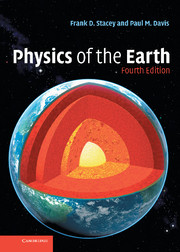Book contents
- Frontmatter
- Contents
- Preface
- 1 Origin and history of the Solar System
- 2 Composition of the Earth
- 3 Radioactivity, isotopes and dating
- 4 Isotopic clues to the age and origin of the Solar System
- 5 Evidence of the Earth's evolutionary history
- 6 Rotation, figure of the Earth and gravity
- 7 Precession, wobble and rotational irregularities
- 8 Tides and the evolution of the lunar orbit
- 9 The satellite geoid, isostasy, post-glacial rebound and mantle viscosity
- 10 Elastic and inelastic properties
- 11 Deformation of the crust: rock mechanics
- 12 Tectonics
- 13 Convective and tectonic stresses
- 14 Kinematics of the earthquake process
- 15 Earthquake dynamics
- 16 Seismic wave propagation
- 17 Seismological determination of Earth structure
- 18 Finite strain and high-pressure equations of state
- 19 Thermal properties
- 20 The surface heat flux
- 21 The global energy budget
- 22 Thermodynamics of convection
- 23 Thermal history
- 24 The geomagnetic field
- 25 Rock magnetism and paleomagnetism
- 26 ‘Alternative’ energy sources and natural climate variations: some geophysical background
- Appendix A General reference data
- Appendix B Orbital dynamics (Kepler's laws)
- Appendix C Spherical harmonic functions
- Appendix D Relationships between elastic moduli of an isotropic solid
- Appendix E Thermodynamic parameters and derivative relationships
- Appendix F An Earth model: mechanical properties
- Appendix G A thermal model of the Earth
- Appendix H Radioactive isotopes
- Appendix I A geologic time scale
- Appendix J Problems
- References
- Name Index
- Subject Index
1 - Origin and history of the Solar System
Published online by Cambridge University Press: 05 July 2013
- Frontmatter
- Contents
- Preface
- 1 Origin and history of the Solar System
- 2 Composition of the Earth
- 3 Radioactivity, isotopes and dating
- 4 Isotopic clues to the age and origin of the Solar System
- 5 Evidence of the Earth's evolutionary history
- 6 Rotation, figure of the Earth and gravity
- 7 Precession, wobble and rotational irregularities
- 8 Tides and the evolution of the lunar orbit
- 9 The satellite geoid, isostasy, post-glacial rebound and mantle viscosity
- 10 Elastic and inelastic properties
- 11 Deformation of the crust: rock mechanics
- 12 Tectonics
- 13 Convective and tectonic stresses
- 14 Kinematics of the earthquake process
- 15 Earthquake dynamics
- 16 Seismic wave propagation
- 17 Seismological determination of Earth structure
- 18 Finite strain and high-pressure equations of state
- 19 Thermal properties
- 20 The surface heat flux
- 21 The global energy budget
- 22 Thermodynamics of convection
- 23 Thermal history
- 24 The geomagnetic field
- 25 Rock magnetism and paleomagnetism
- 26 ‘Alternative’ energy sources and natural climate variations: some geophysical background
- Appendix A General reference data
- Appendix B Orbital dynamics (Kepler's laws)
- Appendix C Spherical harmonic functions
- Appendix D Relationships between elastic moduli of an isotropic solid
- Appendix E Thermodynamic parameters and derivative relationships
- Appendix F An Earth model: mechanical properties
- Appendix G A thermal model of the Earth
- Appendix H Radioactive isotopes
- Appendix I A geologic time scale
- Appendix J Problems
- References
- Name Index
- Subject Index
Summary
Preamble
As early astronomers recognized, the planets are orbiting the Sun on paths that are nearly circular and coplanar, with motions in the same sense as the Sun's rotation, making it difficult to avoid the conclusion that the formation of the Sun led directly to its planetary system. A comparison of the planets (Table 1.1) shows that the Earth belongs to an inner group of four, which are much smaller and denser than the outer four giant planets. For this reason the inner four are referred to as the terrestrial (Earth-like) planets. The outer four large planets are gaseous, at least in their visible outer regions, but they have solid satellites with very varied external appearances and a wide range of mean densities, all much lower than those of the terrestrial planets. The asteroids, which are found between the two groups of planets, are believed to be remaining examples of planetesimals, the pre-planetary bodies from which the terrestrial planets formed. Meteorites are samples of asteroids that have arrived on the Earth, by a mechanism discussed in Section 1.9, and so provide direct evidence of the overall compositions of the terrestrial planets.
We probably learn more about the formation of planets from their differences than from their similarities. Several features of the Earth distinguish it from all other bodies in the Solar System and require special explanations.
(i) The Earth is the only planet with abundant surface water, both liquid and solid.
(ii) It is also the only planet with an atmosphere rich in oxygen.
[…]
- Type
- Chapter
- Information
- Physics of the Earth , pp. 1 - 26Publisher: Cambridge University PressPrint publication year: 2008



